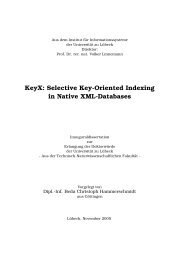Gesture-Based Interaction with Time-of-Flight Cameras
Gesture-Based Interaction with Time-of-Flight Cameras
Gesture-Based Interaction with Time-of-Flight Cameras
Create successful ePaper yourself
Turn your PDF publications into a flip-book with our unique Google optimized e-Paper software.
CHAPTER 2. TIME-OF-FLIGHT CAMERAS<br />
light to the measurements <strong>of</strong> A0, . . . , A3,<br />
In the second case, the generation <strong>of</strong> the signal e(t), the noise sources can only be<br />
partially compensated. One deviation <strong>of</strong> a technical implementation from the mea-<br />
surement principle introduced in Section 2.4 is that the signal e(t) will not be ideally<br />
sinusoidal. This has the effect that the range measurement deviates depending on<br />
the distance <strong>of</strong> the object from the camera. Since this error is systematic, it can be<br />
corrected (Lange, 2000; Rapp, 2007).<br />
Another noise source related to the illumination unit is the so-called photon<br />
shot noise, which is a principal physical limitation <strong>of</strong> sensors based on active il-<br />
lumination. It refers to the fact that light sources do not emit a steady stream <strong>of</strong><br />
photons at well defined time intervals, but that the generation <strong>of</strong> photons happens<br />
according to a Poisson distribution, i.e. the time interval between the emission <strong>of</strong><br />
photons represents a Poisson-distributed random variable. Given that the standard<br />
deviation <strong>of</strong> such a Poisson-distributed random variable is the square root <strong>of</strong> the<br />
mean, the same is true for the standard deviations <strong>of</strong> the samples A0, . . . , A3, i.e.<br />
σAi = sqrt(Ai) ∀i = 0, . . . , 3.<br />
According to Lange (2000) this yields a standard deviation <strong>of</strong> the phase mea-<br />
surement<br />
√<br />
B<br />
∆φ =<br />
A √ 2<br />
and, hence, a standard deviation <strong>of</strong> the range measurement<br />
∆R =<br />
c<br />
4πfmod<br />
√<br />
B<br />
· √ .<br />
cdemodAsig 2<br />
✞ ☎<br />
✝2.7<br />
✆<br />
✞ ☎<br />
✝2.8<br />
✆<br />
Equation (2.8) shows that the measurement accuracy is governed by three factors. As<br />
already mentioned above, a high amount <strong>of</strong> background illumination increases the<br />
measurement error. At the same time, the measurement error is reduced if we in-<br />
creased the optical power <strong>of</strong> the active illumination, i.e. if we increase the amplitude<br />
<strong>of</strong> the signal e(t). Here, care has to be taken in situations where the TOF system has<br />
to comply <strong>with</strong> standards <strong>of</strong> eye safety. Finally, increasing the modulation frequency<br />
also reduces the measurement error. Note however, that a higher demodulation fre-<br />
quency reduces also the disambiguity range and that there is a physical limitation in<br />
terms <strong>of</strong> the circuitry on the sensor that toggles between the samples A0, . . . , A3.<br />
Generally speaking, Equation (2.8) reflects a principal physical limitation <strong>of</strong> the<br />
measurement accuracy and TOF cameras currently on the market are already close<br />
to reaching this limit (Büttgen et al., 2005).<br />
22

















